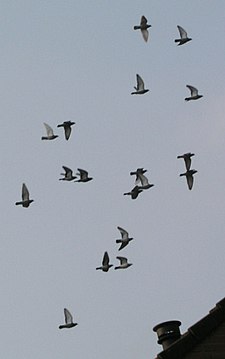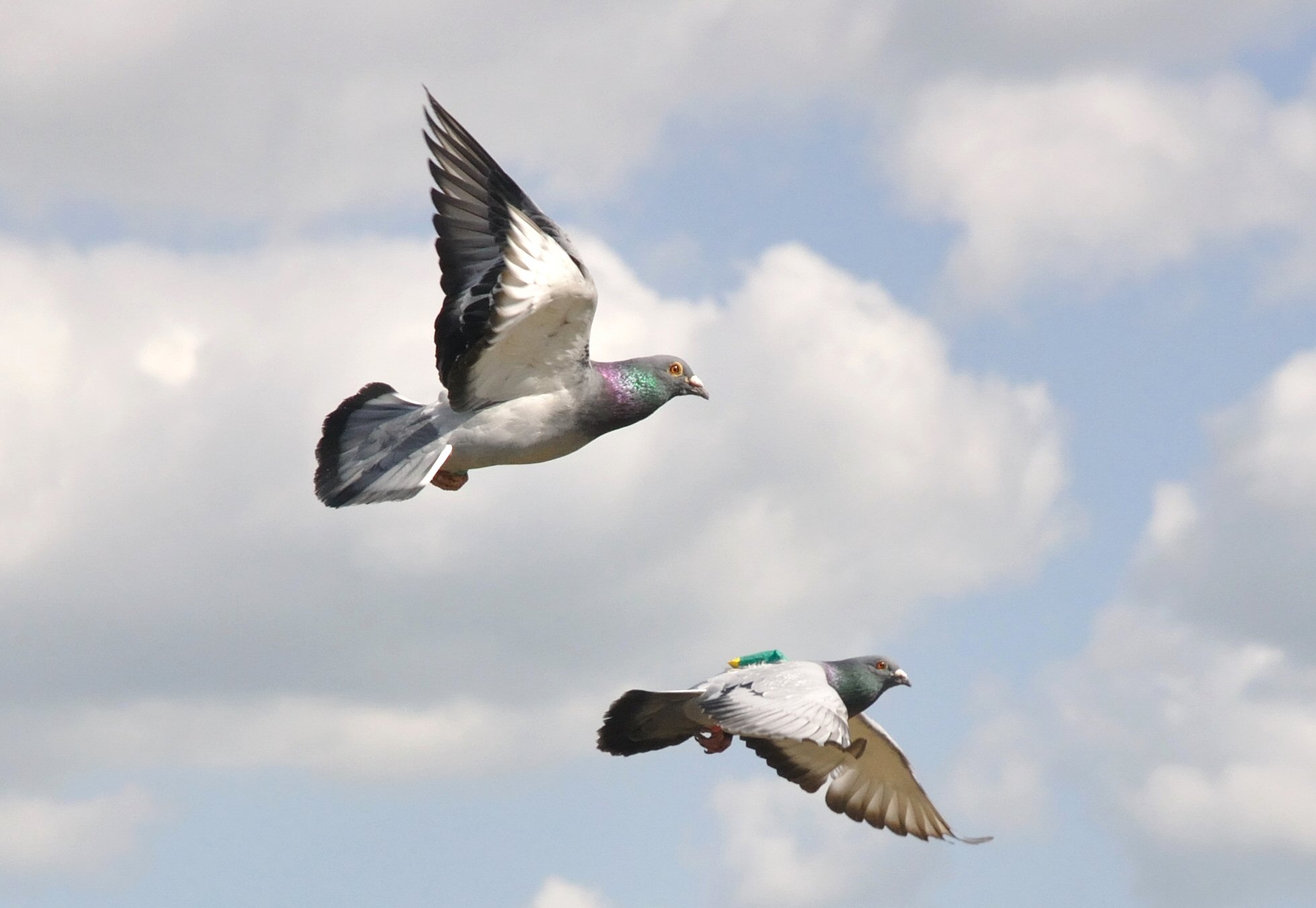Homing pigeons are a breed of pigeon known for their ability to return to their home from long distances with great accuracy. These birds have a remarkable sense of direction and use visual landmarks, the position of the sun, and Earth’s magnetic field to navigate.
In addition to their homing ability, homing pigeons have been used for centuries to carry messages and deliver important communication in times of war and peace. With their unique skills and impressive track record, homing pigeons continue to capture the fascination of people around the world.
We will delve deeper into the characteristics and history of these remarkable birds, shedding light on their extraordinary homing abilities and the ways in which they have been utilized throughout history.
The Fascinating World Of Homing Pigeons
Introduction To Homing Pigeons And Their Remarkable Abilities
Homing pigeons, also known as carrier pigeons, are exceptional birds with remarkable navigational skills. They have the ability to find their way back home from distant locations, even when released hundreds of miles away. This extraordinary talent has long fascinated humans and has been utilized in various ways throughout history.
The History And Importance Of Homing Pigeons In Communication And Transportation
For centuries, homing pigeons have played a crucial role in communication and transportation. Their incredible homing abilities made them invaluable messengers, especially during times when modern means of communication were not available.
During World Wars I and II, homing pigeons were extensively used by the military to deliver messages across enemy lines. They proved to be highly reliable, as they could easily navigate through treacherous terrains and adverse weather conditions. These feathered couriers saved countless lives by providing timely information and facilitating effective military strategies.
In addition to wartime communication, homing pigeons were also employed in civilian life. They served as mail carriers, delivering important documents, letters, and even urgent medical supplies. Before the advent of telegraphs and telephones, homing pigeons provided a reliable means of communication over long distances.
The contributions of homing pigeons were not limited to communication alone. They were instrumental in transportation, particularly in the field of aviation. In the early days of aviation, when aircraft engines were less reliable, homing pigeons were often carried on board as emergency communication devices. In the event of a mechanical failure or a crash landing, the pigeon could be released with a message attached to its leg, ensuring help would be sent to the stranded pilot.
Moreover, homing pigeons were extensively used in racing competitions, where their ability to find their way back home quickly became a source of fascination and admiration. These races attracted considerable attention, with people eagerly following the progress of the birds as they covered vast distances. The sport of pigeon racing is still popular today and showcases the incredible speed and determination of these avian athletes.
In conclusion, the world of homing pigeons is a captivating one, full of incredible abilities and historical significance. Whether it be in delivering wartime messages, transporting mail, or participating in thrilling racing competitions, these birds have left an indelible mark on human history. Their extraordinary navigational skills continue to astonish and serve as a testament to the wonders of the natural world.
The Physical Characteristics Of Homing Pigeons
The physical characteristics of homing pigeons contribute to their impressive flying abilities. These birds possess unique features that set them apart from other pigeons, enabling them to navigate vast distances and find their way back home. In this article, we will explore the key physical attributes that make homing pigeons so remarkable.
Overview Of The Physical Features That Make Homing Pigeons Unique
Homing pigeons exhibit several distinctive physical characteristics that aid in their navigation and flight abilities. Let’s take a closer look at these remarkable features:
1. Excellent Vision
Homing pigeons are endowed with exceptional visual acuity, allowing them to perceive details with great precision. Their keen eyesight enables them to spot familiar landmarks, recognize patterns, and identify their intended destinations. This remarkable vision plays a crucial role in their long-distance flights and homing instincts.
2. Aerodynamic Body Structure
The body of a homing pigeon is crafted for optimal flight performance. Its streamlined shape reduces air resistance, enabling swift movement through the air. The compact size, muscular chest, and strong wings further enhance their ability to maintain stability and control their flight direction, even in challenging weather conditions.
3. Strong Muscles and Endurance
Homing pigeons possess well-developed chest muscles that power their flight. These muscles are incredibly resilient, allowing them to sustain long flights without fatigue. Their stamina is a result of rigorous training and selective breeding, which has fine-tuned their physical capabilities over generations.
4. Magnetic Sensitivity
Homing pigeons possess a unique ability to sense the Earth’s magnetic field. This internal compass helps them navigate and orient themselves accurately, even in unfamiliar territories. Scientists believe that iron-rich cells in the pigeon’s beak or brain may provide the bird with a magnetic sense, aiding their remarkable homing abilities.
How These Characteristics Contribute To Their Flying Abilities
The physical characteristics mentioned above synergistically contribute to the flying abilities of homing pigeons. Here’s how:
- Excellent Vision: Their exceptional eyesight facilitates navigation and helps them locate specific landmarks and recognizable patterns, leading to accurate homing.
- Aerodynamic Body Structure: The streamlined body shape, along with strong wings and muscles, allows homing pigeons to fly at high speeds while maintaining stability and maneuverability.
- Strong Muscles and Endurance: The well-trained, resilient chest muscles enable pigeons to undertake long-distance flights without tiring, ensuring they can cover vast distances.
- Magnetic Sensitivity: By sensing the Earth’s magnetic field, homing pigeons can orient themselves accurately, compensating for the lack of visible landmarks or familiar routes.
These physical characteristics work in harmony, enabling homing pigeons to navigate with precision and return to their home loft, regardless of the distance and geographical obstacles they face. The extraordinary combination of their unique features and innate instincts makes them extraordinary creatures of the sky.
Training Homing Pigeons: A Step-by-step Guide
Training homing pigeons can be a fascinating and rewarding experience. These intelligent birds have a natural ability to navigate and find their way back home, making them ideal for various purposes such as racing, message delivery, or simply as pets. In this step-by-step guide, we will explore the process of training homing pigeons, from understanding their training requirements to teaching them to navigate and return home.
Understanding The Process Of Training Homing Pigeons
Before you embark on training homing pigeons, it’s essential to understand the process and the natural instincts that these birds possess. Homing pigeons have an innate ability to orient themselves using various cues, including the sun, Earth’s magnetic field, and visual landmarks. They also have a strong desire to return to their loft, which serves as their home base.
It’s crucial to start training pigeons when they are young, as they are highly receptive to learning during this period. Pigeons also need to develop a bond with their trainer, so spending quality time with them regularly will be beneficial.
Creating A Suitable Environment For Training
In order to successfully train homing pigeons, creating a suitable environment is crucial. This includes having a secure and comfortable loft for the birds to call home. The loft should provide ample space for the pigeons to move around freely and have access to fresh air and natural light.
Additionally, the loft should be equipped with perches, feeders, and water containers, ensuring the pigeons’ basic needs are met. Maintaining cleanliness and hygiene in the loft is also vital to prevent diseases and keep the birds healthy.
Teaching Homing Pigeons To Navigate And Return Home
Teaching homing pigeons to navigate and return home is the ultimate goal of their training. This process involves several steps:
- Imprinting: Imprinting is the initial step where the young pigeons familiarize themselves with their loft. This is achieved by temporarily confining them in the loft for a few weeks, allowing them to become familiar with the surroundings and establish their home base.
- Short tosses: Once the pigeons have imprinted on their loft, it’s time to introduce them to short tosses. This involves releasing the pigeons a short distance away from their loft, gradually increasing the distance over time. The goal is for the pigeons to navigate and find their way back home. These short tosses help the pigeons develop their navigational skills and reinforce the connection between their loft and home.
- Long tosses: As the pigeons become more experienced and proficient at finding their way back home from short distances, it’s time to progress to long tosses. Long tosses involve releasing the pigeons from progressively longer distances, challenging their navigational abilities even further. This stage helps strengthen their homing instincts and improves their endurance.
- Introducing obstacles: To enhance the pigeons’ navigational skills, obstacles can be gradually introduced during training. This could include releasing them in unfamiliar locations or in various weather conditions. By exposing the pigeons to different situations, they become more adaptable and skilled at finding their way home.
Consistency, patience, and positive reinforcement are key throughout the training process. The pigeons should be rewarded with treats and praise when they successfully navigate and return home. Training sessions should be conducted regularly, gradually increasing the complexity of the tasks.
Training homing pigeons is a gradual process that requires dedication and a deep understanding of their instincts. By following this step-by-step guide, you can develop a strong bond with your pigeons and witness the remarkable navigational abilities that they possess.
Homing Pigeon Racing: A Thrilling Sport
The excitement and popularity of homing pigeon racing:
Homing pigeon racing is a thrilling sport that has gained immense popularity around the world. With its unique combination of speed, strategy, and skill, it captivates both participants and spectators alike. The sight of trained and well-cared-for pigeons taking to the skies, speeding towards their home loft, is an exhilarating experience that sends pulses racing.
In homing pigeon racing, competitions are organized in a meticulous manner to ensure fair play and accurate judging. Racers release their pigeons from a designated location, often at great distances from their home lofts. The birds then race back, utilizing their incredible navigational abilities to find their way.
| Key Elements | Organizing Competitions | Judging Criteria |
|---|---|---|
| Race Course | A carefully designed route with specific distances | Time taken to complete the race, with the fastest bird declared the winner |
| Release Point | A centralized spot where pigeons are simultaneously released | Initial location as a reference point for calculating individual bird’s flight time |
| Timing System | Precision clocks or electronic devices used to record bird arrivals | Accuracy of timing to determine ranking and points |
The importance of proper care and training in racing:
Proper care and training are essential in homing pigeon racing to ensure the birds are in their optimal condition for competitions. Pigeons are meticulously trained to develop their navigational skills and endurance. They are provided with a nutritious diet and undergo regular health check-ups to ensure their well-being.
- Regular exercise routines enhance the pigeons’ physical stamina and speed.
- Training flights help birds familiarize themselves with various terrains and weather conditions.
- Breeding and selecting pigeons with superior genetic traits play a crucial role in racing success.
By investing time, effort, and resources into comprehensive care and training, racers ensure that their pigeons perform at their absolute best, increasing their chances of victory.
Overall, homing pigeon racing is a sport that combines the thrill of competition with the extraordinary abilities of these remarkable birds. From the excitement of races to the meticulous organization and judging, and the essential role of care and training, homing pigeon racing truly has it all.
The Role Of Homing Pigeons In Research And Conservation
When it comes to scientific research and conservation efforts, homing pigeons have proven to be invaluable contributors. These incredible birds possess remarkable abilities that make them ideal partners in studying environmental changes as well as aiding in the protection and conservation of their populations. In this section, we will explore the significant contributions of homing pigeons in scientific research, their role in monitoring and studying environmental changes, and the efforts made to protect and conserve homing pigeon populations.
The Significant Contributions Of Homing Pigeons In Scientific Research
Homing pigeons have made significant contributions to scientific research across various disciplines. Their remarkable homing abilities have been studied extensively, leading to insights into sensory navigation, memory, and cognitive mapping. These studies have not only enhanced our understanding of pigeon behavior but have also provided valuable knowledge that has been applied to other areas of research.
One notable area of scientific research where homing pigeons have made significant contributions is in the field of psychology. Pigeons have been used as subjects in experiments investigating learning, memory, and perception. Their ability to be trained and conditioned has allowed researchers to gain insights into fundamental psychological processes.
Their Role In Monitoring And Studying Environmental Changes
Homing pigeons have proven to be valuable allies in monitoring and studying environmental changes. Their homing instinct enables them to navigate over long distances, making them excellent indicators of changes in the environment. Researchers have utilized homing pigeons to study air quality, pollutant concentrations, and the impacts of climate change.
Through the use of special devices attached to the pigeons, such as GPS trackers and air quality sensors, data can be collected as the birds fly through different areas. This data provides valuable information about pollutant levels and allows researchers to identify pollution hotspots and assess the effectiveness of environmental conservation measures.
Efforts To Protect And Conserve Homing Pigeon Populations
The protection and conservation of homing pigeon populations are essential to maintain their contributions to research and their ecological role. Various initiatives have been undertaken to ensure the preservation of these remarkable birds.
- Breeding programs: Dedicated breeding programs aim to maintain healthy populations and prevent genetic decline. These programs prioritize genetic diversity and work towards ensuring the long-term survival of homing pigeons.
- Habitat conservation: Protecting the natural habitats of homing pigeons is crucial for their survival. Efforts are made to conserve their nesting sites, food sources, and roosting areas, ensuring the preservation of their natural ecosystems.
- Legal protections: Governments worldwide have implemented laws and regulations to safeguard homing pigeons. These measures include prohibitions on hunting, trapping, and disturbance, as well as the establishment of protected areas specifically designated for homing pigeons.
Overall, the role of homing pigeons in research and conservation is indispensable. Their unique abilities and contributions have propelled advancements in scientific understanding and environmental monitoring. Ensuring the protection and conservation of homing pigeon populations is crucial for the continued enrichment of scientific knowledge and the preservation of our natural world.

Credit: en.wikipedia.org
Frequently Asked Questions Of Homing Pigeon Pigeons
How Do You Tell If A Pigeon Is A Homing Pigeon?
To determine if a pigeon is a homing pigeon, look for specific characteristics like a slender body, strong and flexible wings, a small head with alert eyes, and a distinctive band or ring on its leg. Homing pigeons also possess a strong homing instinct, allowing them to navigate and return home from far distances.
Why Are Pigeons Called Homing Pigeons?
Pigeons are called homing pigeons because they have a remarkable ability to find their way back home, even from long distances. Their strong instincts allow them to navigate using celestial cues, landmarks, and magnetic fields.
What Is The Difference Between A Homing Pigeon And A Wild Pigeon?
A homing pigeon is a trained bird used to carry messages, while a wild pigeon is an untrained bird that lives in the wild. Homing pigeons are bred for their ability to navigate and return home, while wild pigeons are adapted to survive in nature.
What Happens If You Find A Homing Pigeon?
If you find a homing pigeon, it’s best to contact a local pigeon racing club or bird rescue organization. They can help locate the pigeon’s owner or provide it with proper care and shelter. It’s important not to keep or harm the pigeon, as they may be on a journey or have a home to return to.
Conclusion
Homing pigeons have a fascinating ability to navigate effortlessly over long distances, making them a symbol of determination and loyalty. These intelligent birds rely on their keen sense of direction, magnetic fields, and landmarks to find their way back home.
Whether used for sport, communication, or as messengers in times of war, homing pigeons have played a crucial role throughout history. Their remarkable skills continue to captivate and inspire us, reminding us of the incredible wonders of the natural world.
Embracing their instinctive homing abilities, we can learn valuable lessons about resilience and the importance of finding our way back, no matter the distance or challenges we face. Homing pigeons truly exemplify the power of navigation and the unwavering desire to return to our roots.

Maruf, a true pigeon aficionado, finds solace and joy in the company of these graceful birds. His unwavering devotion to pigeons is a testament to his deep appreciation for their beauty and grace. Maruf’s passion for caring for and nurturing these feathered friends is truly inspiring to fellow bird enthusiasts.
